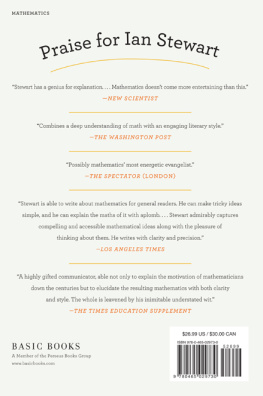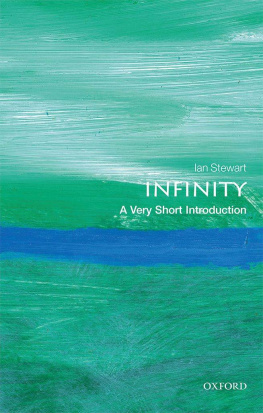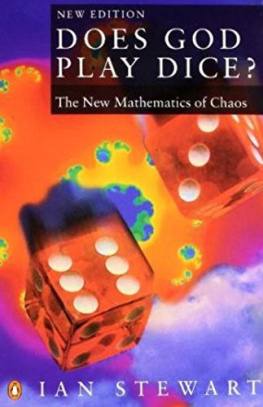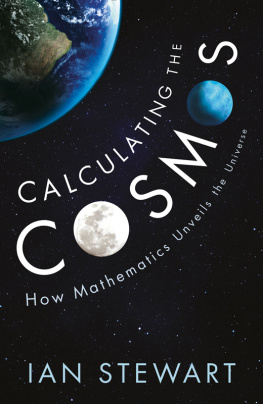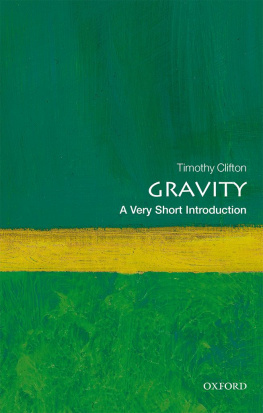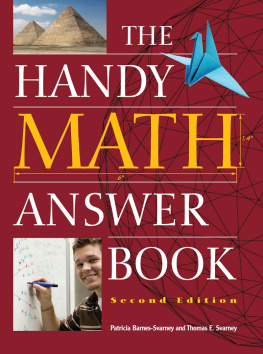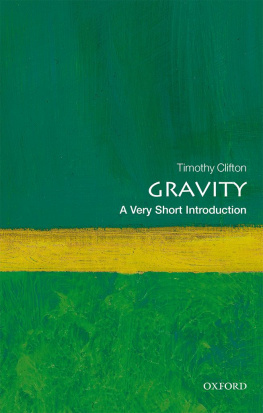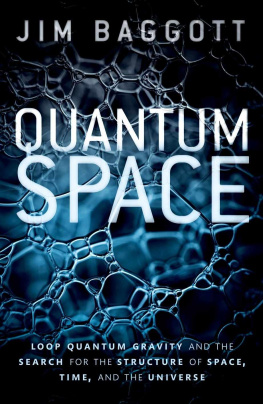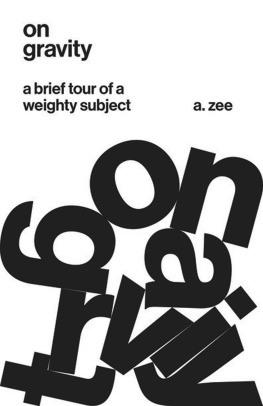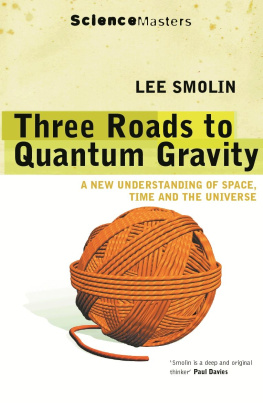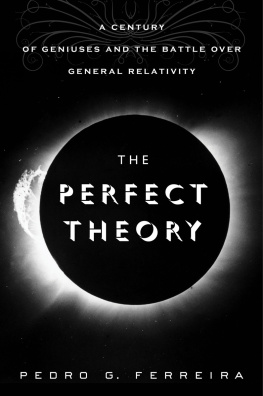
IAN STEWART is Mathematics Professor Emeritus at the University of Warwick. His many books include Incredible Numbers, Seventeen Equations that Changed the World, The Great Mathematical Problems and Professor Stewarts Casebook of Mathematical Mysteries. He is a Fellow of the Royal Society; his research includes work on chaos and dynamics; his awards include the Royal Societys Faraday Medal (1995), the IMA Gold Medal (2000), the American Association for the Advancement of Sciences Public Understanding of Science and Technology Award (2001), the Zeeman Medal (2008), and the Lewis Thomas Prize (2015, joint with Steven Strogatz).
By the same author
Concepts of Modern Mathematics
Game, Set and Math
Does God Play Dice?
Another Fine Math Youve Got Me Into
Fearful Symmetry (with Martin Golubitsky)
Natures Numbers
From Here to Infinity
The Magical Maze
Lifes Other Secret
Flatterland
What Shape is a Snowflake?
The Annotated Flatland
Math Hysteria
The Mayor of Uglyvilles Dilemma
How to Cut a Cake
Letters to a Young Mathematician
Taming the Infinite (Alternative Title: The Story Of Mathematics)
Why Beauty is Truth
Cows in the Maze
Professor Stewarts Cabinet of Mathematical Curiosities
Mathematics of Life
Professor Stewarts Hoard of Mathematical Treasures
17 Equations that Changed the World (Alternative Title: In Pursuit of the Unknown)
The Great Mathematical Problems (Alternative Title: Visions of Infinity)
Symmetry: A Very Short Introduction
Jack of All Trades (Science Fiction eBook)
Professor Stewarts Casebook of Mathematical Mysteries
Professor Stewarts Incredible Numbers
with Jack Cohen
The Collapse Of Chaos
Evolving the Alien (Alternative Title: What Does A Martian Look Like?)
Figments of Reality
Wheelers (Science Fiction)
Heaven (Science Fiction)
The Science of Discworld Series (With Terry Pratchett And Jack Cohen)
The Science of Discworld
The Science of Discworld II: The Globe
The Science of Discworld III: Darwins Watch
The Science of Discworld IV: Judgement Day
iPad app
Incredible Numbers

IAN STEWART

First published in Great Britain in 2016 by
PROFILE BOOKS LTD
3 Holford Yard
Bevin Way
London
WC1X 9HD
www.profilebooks.com
Copyright Joat Enterprises, 2016
The moral right of the author has been asserted.
All rights reserved. Without limiting the rights under copyright reserved above, no part of this publication may be reproduced, stored or introduced into a retrieval system, or transmitted, in any form or by any means (electronic, mechanical, photocopying, recording or otherwise), without the prior written permission of both the copyright owner and the publisher of this book.
A CIP catalogue record for this book is available from the British Library.
eISBN 978 1 78283 150 1
Prologue
Why, I have calculated it.
Isaac Newtons reply to Edmond Halley, when asked how he knew that an inverse square law of attraction implies that the orbit of a planet is an ellipse. Quoted in Herbert Westren Turnbull, The Great Mathematicians.
ON 12 NOVEMBER 2014 an intelligent alien observing the solar system would have witnessed a puzzling event. For months, a tiny machine had been following a comet along its path round the Sun passive, dormant. Suddenly, the machine awoke, and spat out an even tinier machine. This descended towards the coal-black surface of the comet, hit and bounced. When it finally came to a halt, it was tipped over on its side and jammed against a cliff.
The alien, deducing that the landing had not gone as intended, might not have been terribly impressed, but the engineers behind the two machines had pulled off an unprecedented feat landing a space probe on a comet. The larger machine was Rosetta, the smaller Philae, and the comet was 67P/ChuryumovGerasimenko. The mission was carried out by the European Space Agency, and the flight alone took more than ten years. Despite the bumpy landing, Philae attained most of its scientific objectives and sent back vital data. Rosetta continues to perform as planned.
Why land on a comet? Comets are intriguing in their own right, and anything we can discover about them is a useful addition to basic science. On a more practical level, comets occasionally come close to the Earth, and a collision would cause huge devastation, so its prudent to find out what theyre made of. You can change the orbit of a solid body using a rocket or a nuclear missile, but a soft spongy one might break up and make the problem worse. However, theres a third reason. Comets contain material that goes back to the origin of the solar system, so they can provide useful clues about how our world came into being.
Astronomers think that comets are dirty snowballs, ice covered in a thin layer of dust. Philae managed to confirm this, for comet 67P, before its batteries discharged and it went silent. If the Earth formed at its current distance from the Sun, it has more water than it ought to. Where did the extra water come from? An attractive possibility is bombardment by millions of comets when the solar system was forming. The ice melted, and the oceans were born. Perhaps surprisingly, theres a way to test this theory. Water is made from hydrogen and oxygen. Hydrogen occurs in three distinct atomic forms, known as isotopes; these all have the same number of protons and electrons (one of each), but differ in the number of neutrons. Ordinary hydrogen has no neutrons, deuterium has one, and tritium has two. If Earths oceans came from comets, the proportions of those isotopes in the oceans, and in the crust, whose rocks also contain large amounts of water within their chemical make-up, should be similar to their proportions in comets.
Philaes analysis shows that compared to Earth, 67P has a much greater proportion of deuterium. More data from other comets will be needed to make sure, but a cometary origin for the oceans is starting to look shaky. Asteroids are a better bet.
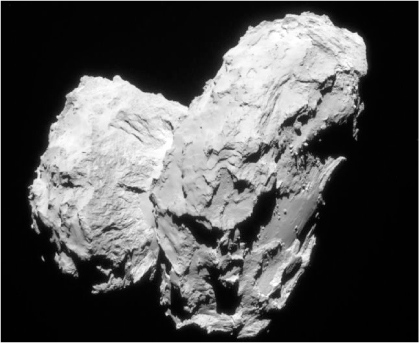
The rubber duck comet 67P, imaged by Rosetta.

The Rosetta mission is just one example of humanitys growing ability to send machines into space, either for scientific exploration or for everyday use. This new technology has expanded our scientific aspirations. Our space probes have now visited, and sent back their holiday snaps of, every planet in the solar system, and some of the smaller bodies.
Progress has been rapid. American astronauts landed on the Moon in 1969. The Pioneer 10 spacecraft, launched in 1972, visited Jupiter and continued out of the solar system. Pioneer 11 followed it in 1973 and visited Saturn as well. In 1977 Voyager 1 and
Next page

